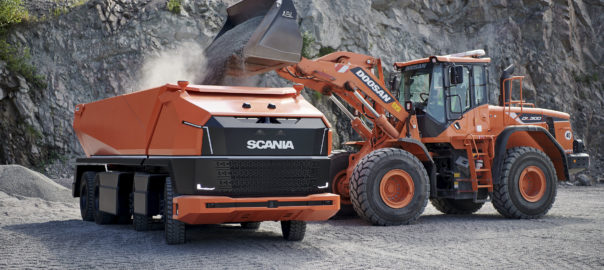In September, Scania joined Komatsu in announcing it had come up with a cabless automated haulage concept for mines and construction sites that, it said, was a significant step towards smart transport systems of the future.
Having the Scania modular system at the heart of the design, the first live demo of Scania AXL took place at TRATON GROUP’s Innovation Day on October 2, at Scania’s demo centre in Södertälje, Sweden.
Following this, IM spoke with Karin Hallstan, Head of Corporate Communications and PR at Scania, to find out a little more about the concept machine.
IM: Why have you decided to launch the AXL now? Why do you think the mining and construction markets are ready for such an innovation?
KH: Autonomous transport solutions, in different levels of technological sophistication, are already well established within the mining industry. Scania already has autonomous trucks in a customer operation (Rio Tinto at the Dampier salt operation in Western Australia).
Also, mines are like closed industrial areas and have trained professionals in command of operations meaning they are well suited for automation. Autonomous vehicles can also make mining operations safer for people employed within the sector.
The reveal of Scania AXL as a concept had to do with Scania having a good opportunity to showcase this in relation to other news we also have planned.
IM: The success of autonomous equipment on mine sites – in terms of boosting productivity, lowering costs, increasing utilisation, etc – has often been predicated on having robust network communications to relay information from the equipment. How will Scania ensure all its customers leverage the technology to its fullest without insisting on 4G/5G/LTE, etc networks.
KH: A certain communications infrastructure will need to be in place to ensure the onboard communications equipment work. Which type and with which capacity may vary.
IM: What payload is the initial concept vehicle? What range of payloads do you expect to cater for in the mining/construction sector?
KH: Scania AXL is based on a 8×4 donor vehicle with a 410 hp diesel engine (G410B8x4NA) running on biofuel HVO (Hydrotreated Vegetable Oil). However, since it is based on Scania’s modular approach, it can be equipped with any engine and wheel configuration available in the Scania modular system. The Scania AXL can load up to 40 tons using existing heavy-duty components.
IM: Based on this, what type of mining operations are you aiming to sell into (coal, iron ore, copper, etc)?
KH: It is important to note that this is a concept which we are building and piloting to primarily learn from in terms of the autonomous capabilities and removing the cab from a truck, rather than something with a set plan to commercialise. We believe that we will start in open-pit mines in this learning process. That said, Scania AXL is specifically constructed with a low tipper truck body that is suitable for underground tunnels with as little as 2.8 m headroom. Above ground, the truck body could be bigger.
IM: You mentioned that this is the first time the company has built a truck that has many new components and technologies – can you expand on what these are and what results you expect to achieve by incorporating them in the AXL design?
KH: The fact that there is no safety driver as backup has led to several innovations with regards to system integration and safety related processes and technical solutions. For example, the original electronic braking system has a ‘safe mode’ that hands control back to the (manual) driver which, in this case, doesn’t exist. Situations like these must be handled with redundancy.
IM: How does the automation system you have developed for the AXL differ to other solutions on the market?
KH: We will comment on our own solutions, not necessarily on others’. What we can say about the automation system for Scania AXL is that the vehicle creates its own picture of its environment and performs its task based on its own view of whether the path/road is drivable and what the assignment is. It is not a solution for automated guidance by GPS-signals or where vehicles follow a loop in the ground.
IM: LiDAR appears to be a big part of the company’s design for the AXL. Has this LiDAR technology been transferred from another vehicle in the Scania range? Or, is it from another sector?
KH: Most of the sensors (radar, LiDAR, antennas and cameras) are, in essence, early prototypes at this stage and are not available in the existing Scania range.
IM: Where and when do you expect to trial the AXL first? What do you anticipate this trial involving (testing out the full capabilities, trialing the self-driving, loading the machine, etc)?
KH: We have trialled it in our own test facilities. If, and when, we work with a customer in a location outside our test environment, we will disclose this broadly publicly.
IM: When could the AXL be available commercially and, going back to a previous question, what payload class is this likely to be in?
KH: This is a concept and a pilot, so we are not commenting on commercial availability.






